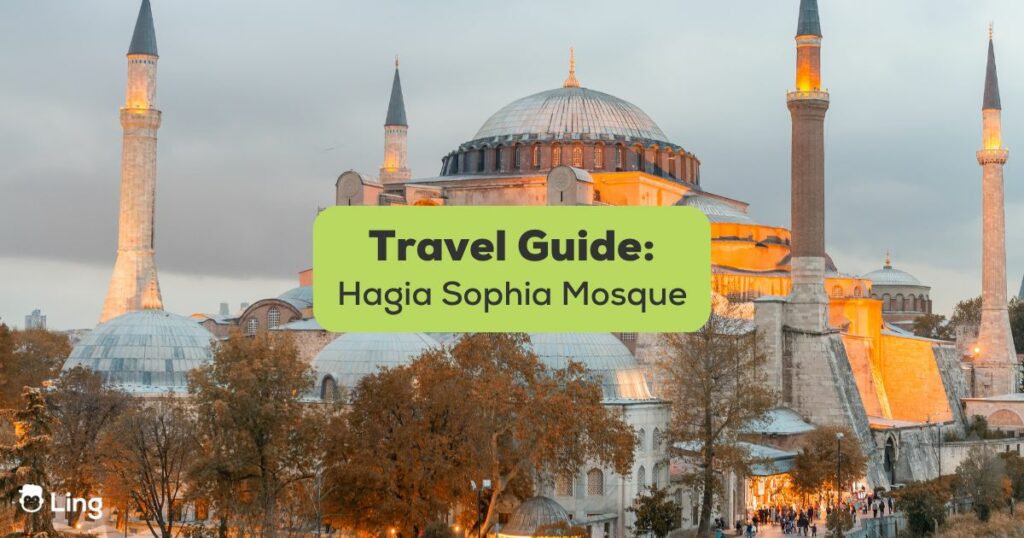Curious about the most famous tourist attraction in Istanbul, Turkey? Then you’ve got to read this exclusive Hagia Sophia Mosque guide!
Hagia Sophia Mosque is a cultural synthesis of Turkish-Islamic and Byzantine architecture. Its design is just way too cool to pass up, so there’s no wonder why it’s also a UNESCO World Heritage Site. As a local, I even find myself surprised that something new catches my eye every single time I go back to this spot.
From a religious person’s perspective, I can say that I’ve never felt more peaceful and closer to God than when praying in the Hagia Sophia Mosque. If you’re religious, I’m sure you’ll experience a similar feeling inside you when you visit it. And if you’re not, the experience is still breathtaking.
Hagia Sophia Mosque Guide
Hagia Sophia is a must-see place in Turkey, but if you want to get the most out of your visit (rather than roaming inside the building with zero knowledge), you should learn about its history and importance. And this Hagia Sophia Mosque guide will help you do that!
When you go there, make sure to also visit the Blue Mosque and Topkapı Palace, which are located in the same area.
Plus, the locals around Sultanahmet Square are very friendly and talkative. If you want to have a conversation about Hagia Sophia or anything else, that’s a good place to do it. So consider learning Turkish by using the Ling app! Download it from the App Store or Play Store before your trip!
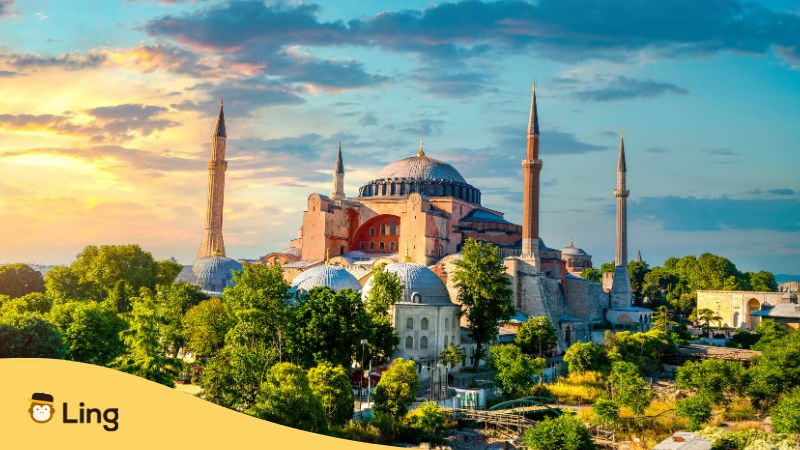
History Of Hagia Sophia: From Church To Mosque
Let’s start by explaining the name Hagia Sophia. It means “Saint Sophia” in Greek, and Sophia means “wisdom.” “The Church of the Holy Wisdom” is dedicated to Christ as the second person of the Holy Trinity, and it’s known as Ayasofya in Turkish.
The Hagia Sophia was initially built as a church. Construction started during the reign of Byzantine emperor Constantine I, but it was completed by Constantine II in 360.
Unfortunately, it was completely burned down during an uprising. Afterwards, Emperor Justinian decided to have a magnificent church built in place of this completely ruined one. Its construction started in 532 and was completed in 537, and the materials used were brought from Mediterranean countries. It’s even said that the columns of the Temple of Artemis were brought to Constantinople and used in Hagia Sophia.
As such, the Hagia Sophia, which has survived to the present day, is the one built by Justinian.
Hagia Sophia then saw its worst days when the city was invaded by the Latins in 1204. When the Eastern Roman Empire regained control in 1261, Hagia Sophia was in ruins. But it was repaired and reopened for worship in 1354 with the help of special taxes and donations collected from the public.
Then, a clean and new page was opened in the life of Hagia Sophia when Fatih Sultan Mehmet (Ruler of the Ottoman Empire) conquered the city in 1453.
After he conquered the city, he took only Hagia Sophia as his share of the spoils. The Sultan then turned the church into a mosque and the first Friday prayer was led by himself as imam.
During the Ottoman period, Hagia Sophia was specially protected by the Sultan. However, he made some minor alterations to turn it into a mosque. No damage was done to the decorations remaining from the years when it was a church; only the mosaic decorations depicting human faces were covered with plaster as they were not allowed by Islamic belief.
After the foundation of the modern Turkish Republic, the Hagia Sophia Mosque was closed to worship in 1932 for restoration purposes. With the permission of the Turkish government, a group of scientists from the USA started working to reveal the mosaics that were covered with plaster. At that time, Hagia Sophia was converted into a museum and opened to visitors as the Hagia Sophia Museum. This means it wasn’t allowed to pray inside for a long time until recently.
In the year 2020, Hagia Sophia was opened to prayer again. Today, it’s once again known as the Hagia Sophia Mosque and is open to both those who want to pray and foreign visitors.
How To Get To Hagia Sophia Mosque?
The Hagia Sophia Mosque is located in Sultanahmet Meydanı, which is in the Eminönü district of Istanbul.
When visiting, you’re most likely to land at Sabiha Gökçen International Airport in Istanbul. From there, the distance to Hagia Sophia is about 45 kilometers.
From the airport, you have many transportation alternatives. You can go by taxi, Uber, or bus. You can also take the HAVABÜS, a special shuttle bus that goes from the airport to Taksim Square. Then, you can take a taxi to Sultanahmet Square.
If you leave the airport and check into your hotel, here is all public transportation that goes to Sultanahmet Square:
- By Bus: 35A, 36, 36ES, 38, 38Z,97, 92B.
- By Subway: M2.
- By Tram: T1.
- By Train: MARMARAY (ATAKÖY – PENDIK), MARMARAY (HALKALI – GEBZE).
On that subject, I’d like to mention a life-saver app for travelers: Moovit! If you want to travel to any location in Istanbul by public transportation for cheaper prices, this app shows you all the alternative vehicles and routes you can take to get to your desired location. Honestly, I couldn’t find my way around Istanbul without this app.
What Is The Best Time To Visit Hagia Sophia?
The Hagia Sophia Mosque is usually crowded at all times, but the peak months are between April and October. During the day, try to visit it as soon as it opens after 9 AM because the area becomes more crowded in the afternoon.
One thing you should keep in mind is that the Hagia Sophia Mosque often goes through construction. So there may be some unwanted scaffolding in your photos. Let’s hope it doesn’t happen during your visit!
Entrance Fee In 2024
The Hagia Sophia entrance fee for foreign tourists is 25 Euros in 2024. Actually, it was free to enter the mosque until January 15, 2024, but now foreign tourists need to buy a ticket. Then again, if you join a guided Hagia Sophia tour, you may be charged more.
According to the official statement, only Turkish citizens who want to pray are allowed to enter from the main gate on the park side of Hagia Sophia, and they will directly reach the ground floor.
As such, foreign tourists must enter the Hagia Sophia Mosque from the new tourist entrance gate, which is located on the side of Topkapi Palace and leads directly to the upper floor.
Visiting Etiquette
When visiting this historical and religious site, there are some considerations you need to keep in mind:
1. Take off your shoes: Make sure to take off your shoes before entering the Hagia Sophia Mosque, because it’s a prayer site and is actively used as a mosque by Muslims. That’s why it is important to keep the floor clean.
2. Cover your head: This rule only applies to women. As in any mosque, you must cover your head with a scarf or shawl before entering. But you don’t need to bring a headscarf with you; they are available for free for foreigners at the entrance.
3. Wear modest clothing: Since it is a mosque, Hagia Sophia visitors should wear clothes that are long enough to cover their knees and shoulders when inside.
4. Avoid visiting on Fridays: The Hagia Sophia Mosque is closed only during noon prayers on Fridays. Please avoid entering the mosque during prayer times.
Inside Hagia Sophia
There are many things to see inside the Hagia Sophia Mosque, and you may not know what to pay attention to. With that in mind, here are the most important things you should see inside the mosque:
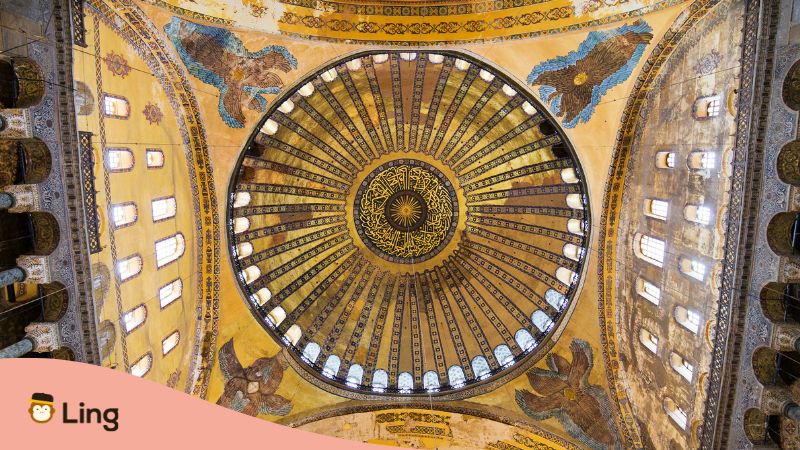
The Grand Dome
Once you enter the Hagia Sophia Mosque, raise your gaze to the ceiling and observe the grand dome. In Turkish-Islamic architecture, the dome represents the heavens and the singularity of Allah (God).
You’ll notice a lot of Arabic calligraphy, they are actually verses from the Holy Qur’an. The following verse is written on the dome:
“Allah is the Light of the heavens and the earth. His light is like a niche in which there is a lamp, the lamp is in a crystal, the crystal is like a shining star, lit from (the oil of) a blessed olive tree, (located) neither to the east nor the west, whose oil would almost glow, even without being touched by fire.”
(Nur, 24/35)
The Wishing Column (Weeping Column)
It’s believed that the weeping column used to be a part of the house of the Virgin Mary. When she heard that Jesus was captured and tortured, she burst into tears and her tears melted the column, creating a hole in it. During the construction of Hagia Sophia, this column was brought to Constantinople and the church was blessed with it.
Today, people put their finger inside this hole, rotate it, and make a wish. That’s why it’s also known as the wishing column.
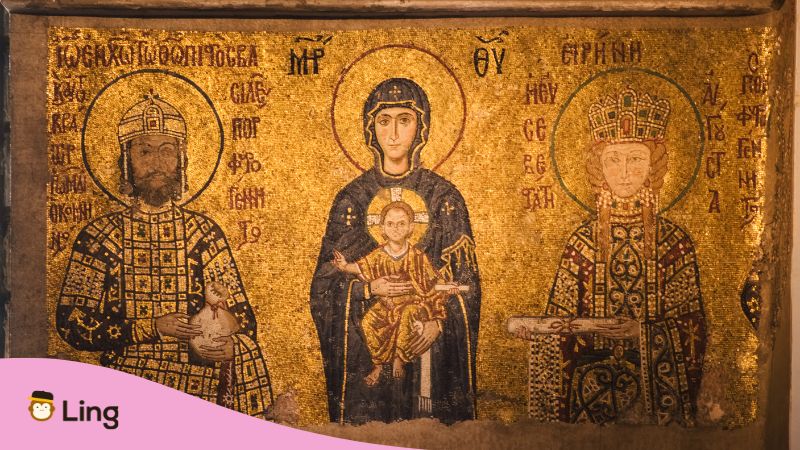
Famous Mosaics
Most of the beautiful mosaics inside Hagia Sophia were created by Byzantine craftsmen between the 10th and 12th centuries. Some materials used in these masterpieces are silver, gold, terracotta, glass, and colored stones. These mosaics feature images of Jesus, the Virgin Mary, kings, and saints. I think these decorative mosaics give Hagia Sophia a royal feel.
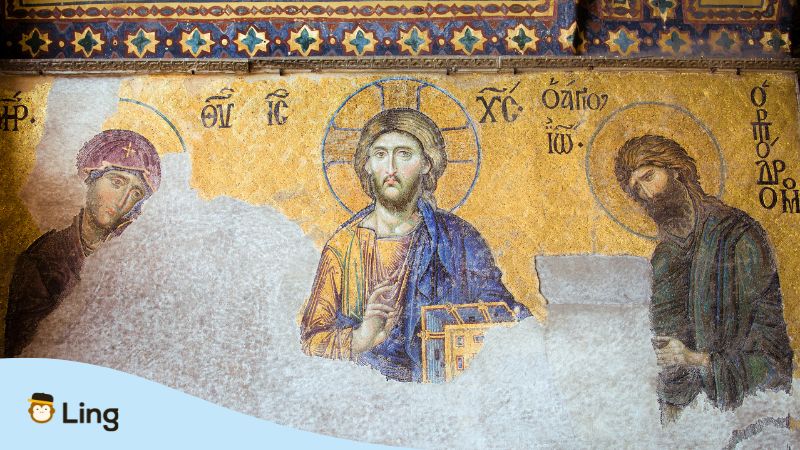
Mosaic Of Jesus Christ
The famous enormous mosaic of Jesus Christ (which is 5 meters in width and 2.6 meters in height) is placed on top of the Imperial Gate. This masterpiece depicts Jesus Christ blessing all humanity while seated on a pinnacle with a halo above his head and a Bible in one hand. On the mosaic, ‘Peace be upon you all; I am the Light of the world’ is witten in the Greek language.
The Emperor’s Gate
The Emperor’s Gate, which dates back to the sixth century, is believed to have been constructed with timbers taken from Noah’s Ark (Nuh’un Gemisi in Turkish). It’s made of oak with bronze frames, intricately decorated, and it’s the largest door in the mosque, measuring 7 meters in height.

Round Calligraphy Panels
There are eight huge (7.5-meter diameter) calligraphic panels inside the Hagia Sophia Mosque. These carry the Arabic names of “Allah,” the name of the Creator in Islam, “Muhammad,” the Prophet of Islam, the four caliphs: “Abu Bakr,” “Uthman,” “Umar,” and “Ali,” and the Prophet’s grandsons, “Hasan” and “Hussain.” All these names were written with gold gilding by the famous calligraphists of Ottomans.
There is a saying about these calligraphic panels. Even if someone wanted to remove them from the mosque, it’s not possible. That’s because these panels are bigger than the doors, and there is no way for them to pass through them!
Ready To Visit The Hagia Sophia Mosque?
Now that you’ve read this Hagia Sophia Mosque guide, you know the history and importance of this amazing building. If you want to learn more, you could also go for an audio guide or join a guided tour, where a Turkish expert will tell you everything you need to know, in English of course.
And if you have any questions regarding your visit, don’t hesitate to ask me in the comments section. I’ll do my best to help you as a local and lover of Hagia Sophia!
